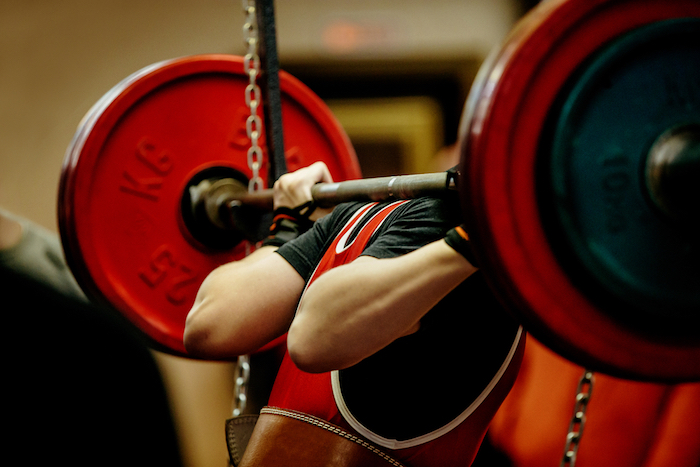Peaking, cutting, sodium manipulation, carb loading, electrolyte replenishment — and we haven’t even mentioned the mental game. The week before a powerlifting meet contains a ton of variables and can be enormously stressful on the lifter, especially if his or her preparation is mismanaged. BarBend sat down with Paulie and Rebecca Steinman, owners of the revered powerlifting and Olympic weightlifting gym South Brooklyn Weightlifting Club, to learn what is and isn’t essential in the week before a meet.

1) Be Realistic
A meet is about testing your limits, yes. But a lot of people overestimate what they’re capable of.
“If you’ve been following a program, monitoring your body weight, and keeping track of your diet, then you should have a good idea of what you will and won’t be able to lift at the meet,” says Paulie. “It’s a reasonable thing to say that I’ll hit a PR if my training, history, and preparation warrants it. But you have to assess your training and assess your position.”
The Steinmans have seen plenty of recreational lifters, functional fitness athletes, or friends of their competitors sign up for a meet just to try and PR, without training specifically for a meet. Almost invariably, these people miss their lifts.
“Strength is the kind of thing where you can’t just hope for magic to happen,” he adds.
2) Trust Your Coach
“What you shouldn’t do is second guess your training, you shouldn’t try to test your maxes or lift too much in the week before you compete,” says Paulie. “Everyone gets nervous and wants to try and hit their numbers before they compete because they don’t trust that they’re going to hit them on the day. But don’t deviate from the course, don’t second guess things.”
Your programming was put into motion weeks, maybe months ago. Stay the course.
3) Pamper Yourself
Like we said, a looming meet can be a real source of stress. That goes double if an athlete has backed off from their lifting – which is probably one of their main stress relievers.
To keep your anxiety and cortisol low, Rebecca recommends a pedicure, manicure, facial, meditation, a movie, or a relaxing massage –not the rigorous, painful sports massage you might be used to.
“A week out from a meet, the training is pretty much done,” she says. “Now you just have to relax and stay healthy, and try not to be too focused on the meet itself. Do something you haven’t done in a while because you’ve been enmeshed in your training.” Haven’t you earned it?
4) Learn the Rules
There are many kinds of powerlifting meets and federations and they often have slightly different rules. Learn them. They should be easy to find and download, and they can save a lot of frustration on the day of the meet.
“Understand the commands, understand the rules, understand what will and won’t get you a red light,” says Paulie. “Know what you can and can’t wear. USA powerlifting won’t let you lift with boxer briefs on. You don’t want to learn that on the day.”
5) Cut Responsibly (Or Not at All)
“If you’ve been competing for less than a year, don’t cut,” says Paulie. “Don’t worry about your weight, don’t worry about your competition, just worry about your performance. I tell our novice lifters to build a base of competition before they start caring what they weigh or even where they place.”
For intermediate and advanced competitors, some of the biggest problems arise when athletes wait too long to start their cut or approach it too aggressively – cutting weight is a skill and it can easily be a distraction. While a guide to cutting is outside the scope of this article, the Steinmans emphasize that your cut should start about a month out from the meet at a rate of about a pound per week.
For the water cut, drink large amounts of water throughout the week until twelve hours before the meet, then cut your water completely. After the weigh in, sip – don’t guzzle – a liter or two of water with a source of electrolytes, like Gatorade.
“But don’t overdo it. Nobody wants to be running to the bathroom when they’re supposed to be lifting,” laughs Rebecca.
6) Pack Your Kit
Don’t wait until the last minute to pack your bag for the meet. Bringing your own weightlifting belt? Wearing deadlifting socks? Got your shoes ready? Pack your bag early; don’t’ let it become a potential source of anxiety. Speaking of which…
7) Bring the Right Food
The day of a powerlifting meet is not the time to experiment with new foods. Don’t eat foods that are going to upset your stomach, don’t’ try a new pre-workout supplement, and don’t eat a lot of protein or fat. You want food that’ll keep you energized and not take too much effort to digest. Carbs and caffeine are the usual go-to, and remember that you might want to eat between your lifts, not just during the two hours after the weigh-in.
Paulie, while quick to note that he’s not a nutrition expert, says that his favorite diet on the day of a meet is a box of pop tarts and a four-pack of Red Bull, but he’s seen lifters PR on everything from donuts to Oreo sleeves. (Eating foods that you might not eat every day can also have a comforting effect, which can be important.) He points out that Mike Tuchscherer, winner of eight USA Powerlifting National Championships, arrives with a loaf of bread and a jar each of peanut butter and jelly and consumes the entire loaf throughout the meet. Find out what works for you. (Talk about a delicious experiment.)
8) Run Through Your Routine
“We tell people to visualize their lifts, visualize their execution, and develop a ritual before a lift,” says Paulie. “Athletes have one minute to set up their lift at a meet. That minute should be practiced in the gym and planned out beforehand.”
For example, consider closing your belt and setting up your wrist straps the same way every time you lift. Some folks like to pace, shake the bar or jump around, but Paulie notes that experienced guys usually minimize their movement, conserve energy, and spend most of their time centering their breath.
Last, but not least, remember that sports should be enjoyable. So, have fun! (And enjoy the donuts.)
Featured image: Michael Stern on Flickr

